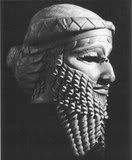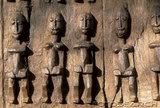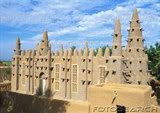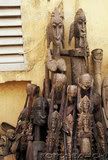Friday, June 1, 2007
African Roots of Humanity and Civilization - Part II -Europe
THE AFRICAN PRESENCE IN EARLY EUROPE
Minoan Crete
The first civilization of Europe was established on the island of Crete. It is called the Minoan Culture, after King Minos, an early legendary ruler of the island. It has been argued that the ancestors of the Cretans were natives of Africa, a branch of Western Ethiopians.
Minoan Crete, the forerunner of Greek civilization, is the earliest known European high-culture. Although modest in size (170 miles east to west, thirty-five miles north to south), Crete exercised immeasurable influence on the Aegean archipelago, Western Asia, and the Greek mainland. Throughout Crete the vestiges of complex palaces, paved highways, aqueducts, terracotta pipes for drainage, and irrigation canals provide plentiful proof of Minoan ingenuity in the areas of scientific and technical innovation. The Minoans possessed registered trademarks, uniform weights and measures, calendrical systems based on precise astronomical observations, and advanced scripts. Interestingly enough, there were few fortifications on the island.
While the cultural and technical prowess of ancient Crete appears relatively well known, the ethnic make-up of the early population and the direction from which sprang its impetus for civilization is much more hotly debated. John G. Jackson advocates the view that Minoan civilization is African-rooted. He believes that the ancestors of the Minoans "dwelt in the grasslands of North Africa before that area dried up and became a great desert. As the Saharan sands encroached on their homeland, they took to the sea, and in Crete and neighboring islands set up a maritime culture."
Arthur Evans (1851-1941), who conducted extensive excavations on the island, was convinced of African migrations to Neolithic Crete. He noted that: "The multiplicity of these connections with the old indigenous race of the opposite African coast, and with which we undoubtedly have to deal with in the predynastic population of the Nile Valley, can in fact be hardly explained on any other hypothesis than that of an actual settlement in Southern Crete."
Moorish Civilizers of Europe
It would not be inaccurate to say that the Moors helped reintroduce Europe to civilization. But just who were the Moors of antiquity anyway? Chancellor Williams has written that "The original Moors, like the original Egyptians, were Black Africans." Much of the apparent confusion about Moorish ethnicity may be related to the fact that the same people who were called Moors in Europe, were known in Arab literature as Berbers. Indeed, in Arabic texts the word Moor was fairly non-existent and the term Berber was applied to practically all the inhabitants of ancient northwest Africa.
Early in the eighth century, after a grim and extended resistance to the Arab invasions of North Africa, the Moors, or Berbers, joined the triumphant surge of Islam. Following this, numbers of them crossed over to the Iberian peninsula, where their swift victories and remarkable feats became the substance of legends.
The man chosen to lead the eighth century probe into Iberia was Tarif, son of Zar`a ibn Abi Mudrik. Tarif was one of the young generation of Islamized Berbers imbued with the military philosophy of Hassan ibn al-Nu`man and Musa ibn Nusayr--the two men who had just commanded the Arab conquest of northwest Africa. In July 710, Tarif, with four-hundred foot soldiers and one-hundred horse, all Berbers, successfully carried out a reconnaissance mission in southern Iberia. Tarifa, a small port in southern Spain, is named after him.
It is clear, however, that the actual conquest of Spain was undertaken upon the initiative of Tarik ibn Ziyad. Tarik ibn Ziyad ibn `Abd Allah ibn Walghu was a member of the Warfadjuma branch of the Nafza Berbers. Musa ibn Nusayr had previously appointed him governor of the far western Maghrib (Islamic North Africa west of Egypt), which covered what is today the southern part of the kingdom of Morocco. Tarik was in command of an army of at least 10,000 men, mainly Sanhadja Berbers.
In 711, with a Berber expeditionary force and a small number of Arab translators and propagandists (some say three-hundred), Tarik crossed the straits and disembarked near a rocky promontory which from that day since has borne his name: Djabal Tarik (`Tarik's mountain'), or, Gibraltar. In August 711, he won a paramount victory over the Visigoth army. It was during this conflict that Roderick (the last Visigoth king) was killed. On the eve of the battle, Tarik is alleged to have roused his troops with the following words: "My brethren, the enemy is before you, the sea is behind; whither would ye fly? Follow your general: I am resolved either to lose my life or to trample on the prostate king of the Romans."
Wasting no time to relish his victory, Tarik pushed on with his seemingly tireless Berber cavalry to Toledo and seized the Visigoth capital. Within a month's time, Tarik ibn Ziyad had effectively terminated Visigothic dominance of the Iberian peninsula.
Musa ibn Nusayr joined Tarik in Spain and helped complete the conquest of Iberia with an army of 18,000 Arab and Berber troops. The two commanders met at Talavera, where Tarik and his Berbers were given the task of subduing the northwest of Spain. With vigor and speed they set about their mission, and within three months they had swept the entire territory north of the Ebro River as far as the Pyrenees, and annexed the turbulent Basque country. There they left a small detachment of men under Munusa, a Berber lieutenant who was later to play a decisive role in the Muslim campaigns in southern France.
In the aftermath of these brilliant struggles, Berbers by the thousand flooded into the Iberian peninsula. So eager were they to come that some are said to have floated over on tree-trunks. Tarik himself, at the conclusion of his illustrious military career, retired to the distant East, we are informed, to spread the teachings of Islam.
St. Maurice: Knight of the Holy Lance
The name Maurice is derived from Latin and means "like a Moor." The Black St. Maurice (the Knight of the Holy Lance) was patron saint of the Holy Roman Empire. The earliest version of the Maurice story and the account upon which all later versions are based, is found in the writings of Eucherius, Bishop of Lyons (ca. 450). According to Eucherius, Maurice was a high official in the The baid region of Egypt--an early center of Christianity. Specifically, Maurice was the commander of a Roman legion of Christian soldiers stationed in Africa. By the decree of Roman emperor Maximian, his contingent of 6,600 men was dispatched to Gaul and ordered to suppress a Christian uprising there. Maurice disobeyed the order. Subsequently, he and almost all of his troops were martyred when they chose to die rather than persecute Christians, renounce their faith, and sacrifice to the gods of the Romans. The execution of the Thebans occurred in Switzerland near Agaunum (which later became Saint Maurice-en-Valais) on September 22, either in the year 280 or 300.
In the second half of the fourth century the worship of St. Maurice spread over a broad area in Switzerland, northern Italy, Burgundy, and along the Rhine. Tours, Angers, Lyons, Chalon-sur-Saone, and Dijon had churches dedicated to St. Maurice. By the epoch of Islamic Spain, the stature of St. Maurice had reached immense proportions. Charlemagne (768-814), grandson of Charles Martel and the most distinguished representative of the Carolingian Dynasty, attributed to St. Maurice the virtues of the perfect Christian warrior. In token of victory, Charlemagne had the Lance of St. Maurice (a replica of the holy lance reputed to have pierced the side of Christ) carried before the Frankish army. Like the general populace, which strongly relied on St. Maurice for intercession, the Carolingian Dynasty prayed to this military saint for the strength to resist and overcome attacks by enemy forces.
A center of extreme devotion to St. Maurice was developed in the Baltic states, where merchants in Tallin and Riga adopted his iconography. The House of the Black Heads of Riga, for instance, possessed a polychromed wooden statuette of St. Maurice. Their seal bore the distinct image of a Moor's head. The existence of nearly three hundred major images of the Black St. Maurice have been catalogued, and even today the veneration of St. Maurice remains alive in numerous cathedrals in eastern Germany.
Sir Morien: Black Knight of the European Middle Ages
Few documents portray the ethnicity of the Moors in medieval Europe with more passion, boldness and clarity than Morien. Morien is a metrical romance rendered into English prose from the medieval Dutch version of the Lancelot. In the Lancelot, it occupies more than five thousand lines and forms the ending of the first extant volume of that compilation. Neither the date of the original poem or the name of the author is known. The Dutch manuscript is dated to the beginning of the fourteenth century. The whole work is a translation, and apparently a very faithful translation, of a French original. It is quite clear that the Dutch compiler understood his text well, and though possibly somewhat fettered by the requirement of turning prose into verse, he renders it with uncommon fidelity.
Morien is the adventure of a splendidly heroic Moorish knight (possibly a Christian convert), supposed to have lived during the days of King Arthur and the Knights of the Round Table. Morien is described as follows: "He was all black, even as I tell ye: his head, his body, and his hands were all black, saving only his teeth. His shield and his armour were even those of a Moor, and black as a raven."
It is noted that Morien was as "black as pitch; that was the fashion of his land--Moors are black as burnt brands." Ultimately, and ironically, Morien came to personify all of the finest virtues of the knights of medieval Europe. According to Gerald Massey (1829-1907), "Morion is said to have been the architect of Stonehenge.... Now, as a negro is still known as a Morien in English, may not this indicate that Morien belonged to the black race, the Kushite builders?" It should be noted that for a very long period the Dutch language used Moor and Moriaan for Black Africans. Among the Lorma community in modern Liberia, the name Moryan is still prominent.
The Expulsion and Dispersal of the Moors
In Iberia, Christian pressures on the Moors grew irresistible. Finally, in 1492, Granada, the last important Muslim stronghold in al-Andalus, was taken by the soldiers of King Ferdinand and Queen Isabella, and the Moors were expelled from Spain. In 1496, to appease Isabella, King Manuel of Portugal announced a royal decree banishing the Moors from that portion of the peninsula. The Spanish king Philip III expelled the remaining Moors by a special decree issued in 1609. Fully 3,500,000 Moors, or Moriscos, as their descendants were called, left Spain between 1492 and 1610. Over a million Moors settled in France. Others moved into Holland. A very curious story in the Netherlands is that of Zwarte Piet (Black Peter). By some accounts Zwarte Piet, the companion to Sinterklaas (Santa Claus), was a Moorish orphan boy whom Sinterklaas adopted and trained as his assistant!
Britons and Vikings
David MacRitchie (1851-1925), author of Ancient and Modern Britons, was convinced that the Moors were Black people who played an important role in the early settlement of Britain:
"For although it may not be easy to trace their route hither, and the date of their arrival, a branch of this family did inhabit Britain, and are not only known as Mauri and Moors, but also as Moravienses, Morienses, Murray-men, and people of Moray or Moravia.
The `Moors' are still largely represented throughout the British Islands; although of course the crossing and re-crossing of thirty generations, while increasing the number of descendants, has lessened the intensity of the resemblance to the ancestral stock. But the swarthy hue asserts itself still, though in a modified degree. Last century, when Martin described the Western Islands of Scotland, he remarked that the complexion of the natives of Skye was `for the most part black,' of the natives of Jura he said that they were generally black of complexion,' and of Arran that they were `generally brown, and some of black complexion.'
The legends and the history of the Scottish Highlands are both witnesses to the existence of purely black people. The Welsh traditions bear a similar testimony. The hero Peredur, Son of Evrawc, discovers a company of `bald, swarthy youths,' sitting at the hall- door of a black giant, playing at chess. This giant is styled the Black Oppressor, and seems to have been of the same genial nature as the `black knight' of Ashton-under-Lyne. He very frankly informs Peredur that `for this reason I am called the Black Oppressor, that there is not a single man around me whom I have not oppressed; and justice have I done unto none.'"
A prominent Viking of the eleventh century was Thorhall, who was aboard the ship that carried the Vikings to the shores of North America. Thorhall was "the huntsman in summer, and in winter the steward of Eric the Red. He was, it is said, `a large man, and strong, black, and like a giant, silent, and foul-mouthed in his speech, and always egged on Eric to the worst; he was a bad Christian.'" We also have knowledge of the "African sea-rovers, the Fomorians, who had a main stronghold on Tory Island, off the Northwest Coast," and who came to be regarded as the "sinister forces in Irish mythology."
Alexander Sergeievich Pushkin: Great Black Russian
Of all the Blacks in Russian history, few have achieved greater fame than Alexander Sergeievich Pushkin. Born in Moscow on May 26, 1799 of well-to-do parents--members of the Russian aristocracy, Pushkin was proudly descended, on his mother's side, from Major-General Ibrahim Petrovich Hannibal--an Ethiopian prince who became a favorite of Tsar Peter I (1682-1725). Pushkin has been positively identified as the very father of Russian literature. He composed in the Russian language at a time when most, if not all, Russian intellectuals were writing in French. Pushkin died prematurely, defending his honor in a duel, in January 1837. Today, Pushkin's name is loftily borne by twenty museums. Of Pushkin, Feodor Dostoevsky (1821-1881) wrote:
"No Russian writer was ever so intimately at one with the Russian people as Pushkin... Without him (Pushkin) we should have lost, not literature alone, but much of our irresistible force, our faith in our national individuality, our belief in the people's power, and most of all our belief in our destiny."
Maxim Gorky (1868-1936) wrote that, "Pushkin is the greatest master in the world. Pushkin, in our country, is the beginning of all beginnings. He most beautifully expressed the spirit of our people." Allison Blakley writes that, "Pushkin was truly the Russian counterpart to Shakespeare."
http://blackherbals.com/african_roots_of_humanity_and_ci.htm
Labels: African Roots of Humanity and Civilization - Part III - Europe
Subscribe to Comments [Atom]







